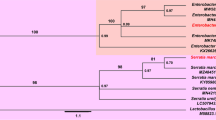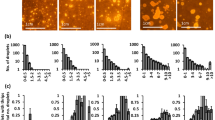Abstract
The virulence of the DAT F-001 isolate ofMetarhizium anisopliae forAdoryphorus couloni was tested by exposing final instar larvae (L3) to concentrations of 101 to 107 spores/g in a sand-peat mix for up to 112 days at 20°±2°C. All concentrations were pathogenic to L3 larvae and survival was dependent on concentration and correlated with exposure time. The time to kill 50% of the treated larvae (LT50) ranged from 18.9 days (107 spores/g) to 82.7 days (101 spores/g). The effect of DAT F-001 on feeding by L3 larvae was determined by comparing the production and weight of frass pellets/larva/day of untreated control larvae with larvae rolled in sporulating cultures ofM. anisopliae DAT F-001 and DAT F-054 (low virulence). Exposure to, and infection byM. anisopliae DAT F-001 had minimal impact on larval feeding. L3 larvae continued to feed at the same rate as both untreated and DAT F-054 treated larvae virtually until they died.
Résumé
La virulence deM. anisopliae DAT F-001 pourA. couloni a été analysée en exposant des larves L3 à des concentrations de 101 à 107 spores/g dans un mélange de sable et de tourbe pendant un maximum de 112 jours à une température de 20°±2°C. Toutes les concentrations sont pathogènes pour les larves L3; la survie dépendait de la concentration et est en corrélation avec le temps d'exposition. Les LT50 sont compris entre 18,9 jours (107 spores/g) et 82,7 jours (101 spores/g). L'effet de DAT F-001 sur l'alimentation des larves L3 a été évalué en comparant la production et le poids des fèces/larve/jour des larves non-traitées avec des larves roulées dans des cultures sporulées deM. anisopliae DAT F-001 et DAT F-054 (faible virulence). L'exposition àM. anisopliae DAT F-001 suivie de l'infection a peu d'effet sur l'alimentation des larves. Les larves L3 continuent à s'alimenter au même rythme que les larves non-traitées de DAT F-054, quasiment jusqu'à leur mort.
Similar content being viewed by others
References
Bullard, G., Pulsford, D. & Rath, A. C. — 1993. BioGreen — A newMetarhizium anisopliae product for the control of pasture scarabs in Australia. In: Soc. for Invert. Pathol. XXVI Ann. Meeting, Program and Abstracts. August 1–6, 1993, Asheville, NC USA. 38.
Doberski, J. W. — 1981. Comparative studies on three fungal pathogens of the Elm bark beetleScolytus scolytus: Effect of temperature and humidity of infection byBeauveria bassiana, Metarhizium anisopliae andPaecilomyces farinosus. —J. Invertebr. Pathol., 37, 195–200.
Doberski, J. W. &Tribe, H. T. — 1980. Isolation of entomogenous fungi from Elm bark and soil with reference to ecology ofBeauveria bassiana andMetarhizium anisopliae. —Trans. Brit. mycol. Soc., 74, 95–100.
Ferron, P. — 1978. Biological Control of Insect Pests by Entomogenous Fungi. —Ann. Rev. Entomol., 23, 409–442.
Ferron, P. — 1981. Pest control by the fungiBeauveria andMetarhizium. In: Microbial control of pests and diseases 1970–1980. (H. D. Burges, ed). —Academic Press, N.Y., 465–482.
Finney, D. J. — 1971 Probit Analysis (3rd Edition). —Cambridge University Press, Cambridge.
Genstat 5 Reference Manual. — 1987.Clarendon Press, Oxford. 749 p.
GLIM System, The. — 1987. Release 3.77 User's Guide. 2nd Edition. (C.D. Payne ed.) —Numerical Algorithms Group, Oxford, U.K.
Guy, P. L. &Rath, A. C. — 1990. Enzyme-linked immunosorbent assays (ELISA) to detect spore surface antigens ofMetarhizium anisopliae. —J. Invertebr. Pathol., 55, 435–436.
Healy, M. J. R. — 1988. GLIM: An Introduction. —Clarendon Press, Oxford. pp. 80–88.
Jackson, T. A., Huger, A. M. &Glare, T. R. — 1993. Pathology of amber disease in the New Zealand grass grubCostelytra zealandica (Coleoptera: Scarabaeidae). —J. Invertebr. Pathol., 61, 123–130.
Krueger, S. R., Villani, M. G., Nyrop, J. P. &Roberts, D. W. — 1991. Effect of soil environment on the efficacy of fungal pathogens against scarab grubs in laboratory bioassay. —Biological Control 1, 203–209.
Krueger, S. R., Villani, M. G., Martins, A. S. &Roberts, D. W. — 1992. Efficacy of soil applications ofMetarhizium anisopliae (Metsch.) Sorokin conidia, and standard and lyophilized mycelial particles against scarab grubs. —J. Invertebr. Pathol., 59, 54–60.
McCoy, C. W., Samson, R. A. &Boucias, D. G. — 1988. Entomogenous fungi. In: CRC Handbook of Natural Pesticides Vol. 5: Microbial Insecticides. Part A. (C. M. Ignoffo, ed.). —CRC Press. Florida, 151–236.
McCullagh, P. &Nelder, J. A. — 1983. Generalised Linear Models.Chapman and Hall Ltd., London, p. 11.
McDowell, J. M., Funderburk, J. E., Boucias, D. G., Gilreath, M. E. &Lynch, R.E. — 1990. Biological activity ofBeauveria bassiana againstElasmopalpus lignosellus (Lepidoptera: Pyralidae) on leaf substrates and soil. —Environ. Entomol., 19, 137–141.
McQuillan, P. B. &Ireson, J. E. — 1987. Tasmanian pasture pests — Identification and control. —Department of Primary Industry and Fisheries, Hobart, 44 p.
Milner, R. J. — 1989. Ecological considerations on the use ofMetarhizium anisopliae for control of soil-dwelling pests. In: Proc. of a soil-invertebrate workshop. (L. N. Robertson & P. G. Allsopp, eds). —Queensland Department of Primary Industries Conference and Workshop Series QC89004, 10–13.
Milner, R. J. & Lutton, G. G. — 1976.Metarhizium anisopliae: Survival of conidia in the soil. —Proc. 1st Int. coll. Invert. Path., Kingston, Ontario, 428–429.
Moscardi, F. — 1988. Production and Use of Entomopathogens in Brazil. In: Biotechnology, Biological Pesticides and Novel Plant-Pest Resistance for Insect pest Management (D. W. Roberts &R. R. Granados, eds). —Cornell University, New York, 55–60.
Müller-Kögler, E. &Stein, W. — 1970. Gewachshausversuche mitBeauveria bassiana (Bals.) Vuill. zur Infektion vonSitona lineatus (L.) (Coleopt., Curcul.) im Boden. —Z. angew. Ent., 65, 59–76.
Müller-Kögler, E. &Stein, W. — 1976. Gewachshausversuche mitMetarhizium anisopliae (Metsch.) Sor, zur Infektion vonSitona lineatus (L.) (Coleopt., Curcul.) im Boden. —Z. Pflanzen Kr. Pflanzensch., 83, 96–108.
Rath, A. C. — 1992.Metarhizium anisopliae for control of the Tasmanian pasture scarabAdoryphorus couloni In: The Use of Pathogens in Scarab Pest Management (T. A. Jackson &T. R. Glare, eds). —Intercept, Andover, 217–227.
Rath, A. C., Anderson, G. C., Worledge, D. &Koen, T. B. — 1995a. The effect of low temperatures on the virulence ofMetarhizium anisopliae (DAT F-001) to the subterranean scarab,Adoryphorus couloni. —J. Invertebr. Pathol., 65, 186–192.
Rath, A. C. &Pearn, S. — 1993. Development of economic control of the root-feeding cockchafer,Adoryphorus couloni (Coleoptera: Scarabaeidae) with the fungusMetarhizium anisopliae. In: Pests of Pastures: Weed, Invertebrate and Disease Pests of Australian Sheep Pastures (E. S. Delfosse, ed). —CSIRO, Melbourne 332–336.
Rath, A. C. &Rowe, B. A. — 1993. Pasture composition is maintained by controlling the scarab,Adoryphorus couloni, withMetarhizium anisopliae. In: Proc. 6th Australasian Conf. on Grassland Invert. Ecol (R. A. Prestidge, ed). —AgResearch, Hamilton, 312–317.
Rath, A. C., Worledge, D., Anderson, G. C. &Carr, C. J. — 1995b. Virulence of the entomogenous fungiMetarhizium anisopliae (Metschn.) Sorokin,M. flavoviride Gams & Rozsypal andBeauveria bassiana (Ballsamo) to redheaded pasture cockchafer,Adoryphorus couloni (Burmeister) (Coleoptera: Scarabaeidae). —J. Aust. ent. Soc., 34, 181–186.
Rath, A. C. & Yip, H. Y. — 1989. Long-term control of the root feeding cockchafer,Adoryphorus couloni (Coleoptera: Scarabaeidae) with the entomogenous fungusMetarhizium anisopliae. InProceedings of a Soil-Invertebrate Workshop. (L. N. Robertson & P. G. Allsopp, eds). —QDPI conference and workshop series, QC 89004, 2–5.
Smith, D. — 1984. Maintenance of Fungi. In: Maintenance of microorganisms (B. E. Kirsop &J. J. S. Snell, eds). —Academic Press, London, 83–107.
Yanagita, T. — 1990. Natural Microbial Communities: Ecological and Physiological Features. —Springer-Verlag, Tokyo, pp. 40–50.
Author information
Authors and Affiliations
Rights and permissions
About this article
Cite this article
Rath, A.C., Worledge, D. The effect ofMetarhizium anisopliae (DAT F-001) concentration and exposure time on the survival of the subterranean pasture pest,Adoryphorus couloni (Col.: Scarabaeidae) . Entomophaga 40, 35–45 (1995). https://doi.org/10.1007/BF02372679
Received:
Accepted:
Issue Date:
DOI: https://doi.org/10.1007/BF02372679




